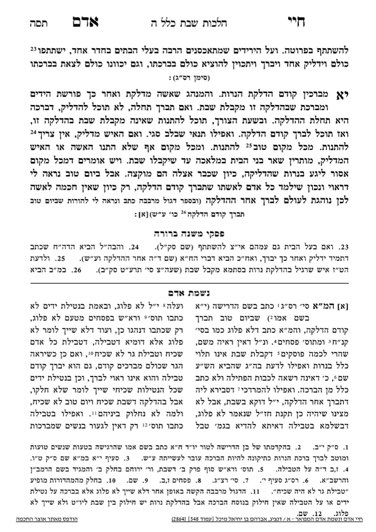We are continuing in siman 11, discussing the bracha on the neiros. We learned that out of concern that by making the bracha on the neiros a woman accepts Shabbos, she does not make the bracha until after lighting the neiros.
We need to discuss whether a woman can make a tnai that she is not accepting Shabbos through her bracha. The Chayei Adam writes that in a case of necessity, a woman can make a tnai that she is not accepting Shabbos through her bracha and hadlakah. In such a situation, she could also make the bracha before lighting. It is sufficient to make this tnai in her mind and she does not need to verbalize it.
There is a machlokes rishonim within the opinion of the BeHa”G, who is the opinion that a woman accepts Shabbos by lighting the neiros. There is a machlokes within this opinion whether a tnai works or not. One opinion is that making the bracha creates an automatic acceptance of Shabbos. It would be akin to davening maariv, where we say mekadeish haShabbos, yet attempting to make a stipulation that one is not accepting Shabbos. Obviously, it does not work. Similarly, for a woman, hadlakas neiros serves as her kabbalas Shabbos, so even if she states that she does not intend to accept Shabbos, she has accepted Shabbos through her bracha.
The other opinion is that it is different from davening maariv. When one davens maariv, they are stating that it is currently Shabbos. When one says lehadlik ner shel Shabbos, they are saying that they are lighting neiros for Shabbos, but not necessarily that it is currently Shabbos. In addition, we learned yesterday that the primary mitzvah is not the lighting, but the benefit received from the light afterwards. If so, the bracha is on the hechsher mitzvah, and not necessarily on accepting Shabbos itself. Thus, even if one normally accepts Shabbos through their hadlakah, a tnai would work.
Thus, it is a machlokes rishonim whether a tnai works. Therefore, the Magen Avraham writes that one should only rely on a tnai in a case of necessity. On the other hand, once one is making a tnai, they can make the bracha before lighting, because if they are able to perform melacha after lighting, they can certainly make the bracha beforehand.
Our minhag is to make the bracha afterwards even when a woman makes a tnai, because of a lo plug, out of concern that it may be confusing and cause a woman to make a mistake.
We have learned that when a woman is running late, and does not have time for both mincha and hadlakah, she should light and daven maariv twice. Why does she not make a tnai, and then daven mincha after lighting? Rav Shlomo Zalman, ztl, wites rthat a woman can make such a tnai.
The Chayei Adam continues, and writes that if a man is lighting, he does not need to make a tnai. Nevertheless, it is appropriate to make a tnai. If a man is lighting, generally that means that he is lighting at home and then going to shul to daven mincha. If he accepts Shabbos through his lighting, he would not be able to daven mincha after lighting. Since it is the standard sequence of events, it is equivalent to making a tnai, and there is no need to make one. Therefore, the order will be to make the bracha before lighting, like any other mitzvah. Nevertheless, it is still appropriate to make the tnai if one is able to.
Summary
- In a case of necessity, a woman can make a tnai that she does not accept Shabbos through lighting neiros. She should think the tnai or verbalize it. She can make the tnai in order to daven mincha after lighting as well.
- When a man is lighting, he does not need to make the tnai, as it is assumed that he is not accepting Shabbos by lighting.
- Even for a man, making a tnai is preferred.



